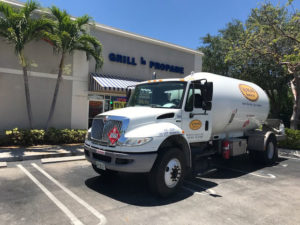
 Facts About Propane
Facts About Propane
- Propane is heavier than air
- Propane is both a liquid and a gas
- Propane is non-toxic
- Propane is colorless and odorless in nature
- Propane is stored under pressure as a liquid, and boils at -44°Fahrenheit
- Liquid propane expands 270 times when exposed to the atmosphere
- Propane Is ranked as the fourth most important source of energy In the country
- There are over 60 million users of propane nationwide. A There are an estimated 4 million users of propane in Florida
- 85% of all propane used in the United States is manufactured domestically
- 92% of all recreational vehicles are fueled or equipped with propane gas or propane gas appliances
What is propane?
Propane, LP gas, bottled gas, butane, and propylene are some of the names used to identify liquefied petroleum gas.
LP gases are in the family of hydrocarbons, but not all hydrocarbons are liquefied petroleum gases.
Propane is normally stored in a pressure vessel as both a vapor and a liquid under moderate pressure.
In its natural state it is colorless, tasteless, odorless and non-toxic. It is produced through the oil refining process or is stripped out of natural gas.
In most cases an odorant is added to serve as a warning agent of a possible gas leak. The odorant most commonly used is Ethyl Mercaptan.
Propane expands
Propane liquid will expand 270 times as it changes from a liquid state to vapor state.
For example, 1 gallon of liquid stored under pressure in a container will expand to approximately 270 gallons of vapor if released to the atmosphere. Consequently, a small amount of liquid propane has the potential to create a serious hazard.
This rapid expansion ratio of 270:1 makes propane an effective refrigerant.
Propane temperature
Propane boils at 44 degrees below zero (-44°).
Through this refrigeration process, heat is rapidly absorbed. As liquid propane converts to vapor through the 270:1 expansion ratio, the rapid conversion of liquid to vapor causes intense chilling that literally freezes whatever it comes in contact with.
For this reason, precautions should be taken to protect eyes and skin from the liquid since freeze burn or frostbite is possible.
First aid treatment for frostbite is the application of lukewarm water to the affected area. As with any serious burn, immediate medical treatment should be sought.
Propane specific gravity
Specific Gravity is the weight of a product compared to the weight of water or air.
The specific gravity of propane vapor is 1.50; air is 1. This means that propane vapor weighs one and one-half times more than air. The specific gravity of propane liquid is 0.504; water is 1.
Therefore, we know that propane liquid is lighter than water. Since propane is heavier than air, it PROPANE IS HEAVIER THAN AIR will normally seek out low areas. This behavior, however, can easily be affected by air currents.
The fact that propane is heavier than air also creates the hazard of a simple asphyxiant.
Oxygen needed to sustain life can be displaced by propane. If a large accumulation of liquid or vapor is present, always remain upwind.
Never enter a concentrated area of propane vapor. Inhaling vapor can cause dizziness, anesthesia, and respiratory arrest.
Propane weight
One gallon of propane weighs 4.2 pounds.
Approximate Properties Of LP Gases (Commercial Propane)
| Vapor Pressure in PSIG at: 70° F 100° F 104° F 130° F |
127 PSIG
195 PSIG 210 PSIG 287 PSIG |
| Specific Gravity of Liquid at 60° F |
0.504
|
| Initial Boiling Point at 14.7 PSI |
-44° F
|
| Weight per Gallon of Liquid at 60° F |
4.20
|
| Specific Heat of Liquid, Bulb at 60° F |
0.630
|
| Cubit Ft. of Vapor per Gallon at 60° F |
36.6
|
| Cubit Ft. of Vapor per Pound at 60° F |
8.66
|
| Specific Gravity of Vapor at 60° F (air = 1) |
1.50
|
| Ignition of Temperature in Air |
920° F to 1120° F
|
| Maximum Flame Temperature in Air |
3,595° F
|
| Limits of Flammability in Air, Percent of Vapor in Air/Gas Mixture a) Lower b) Upper |
|
| Latent Heat of Vaporization at Boiling Point a) BTU Per Pound b) BTU Per Gallon |
184 |
How Outside Temperature Affects Propane
Temperature has a direct relationship to propane pressure.
A pot of water placed on a stove at a high temperature will eventually boil over.
In the same way, an increase in outside temperatures will cause an increase in the pressure in an LP gas container.
As the pressure increases, the volume of the liquid will also expand in the container.
For example, water expands 2.2%. At a temperature rise from 160° F to 600° F, liquid propane would expand 25% and steel would expand only 0.19%.
The fact that propane reacts more quickly to outside temperature changes and expands more rapidly emphasizes the importance of NEVER overfilling an LP gas container.
No LP container may be filled to more than 80% of its capacity without temperature correction.
This means that a container filled to the legal limit will propane stored inside as both a vapor and a liquid (as shown below), allowing for expansion within the container.





